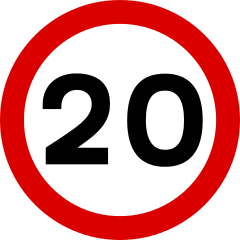
What’s the Speed Limit on this road?
What’s the Speed Limit on this road?
Being able to know what the speed limit is on a particular road is really important. For a start you could get fined and get points on your license for going over the limit and also you are more likely to have an incident that may cause damage to your vehicle or someone else’s or even injure yourself or a pedestrian.
Of course, speed limits are not a target. They are the maximum speed allowed but only if it is safe to do so. You must assess the risk on each stretch of road and think about things such as weather and road conditions and what other hazards may increase the risk.
Speed limit signs are usually round and have a red border with the particular speed limit written on it. The exception to this is the national speed limit sign. In some situations the speed limit is also painted on the road surface.

A speed limit of 30mph usually applies unless you see signs showing otherwise. As a general rule if you don’t see any speed limit signs and it’s a built up area ( regular spaced street lighting) you can usually assume it’s a 30mph limit until you see signs saying otherwise. In higher speed limits once you are in that zone you will usually see regularly spaced reminder or repeater speed limit signs to remind you of the limit.
More commonplace these days are 20 mph zones and they are often near to schools and built up urban areas. As you approach you will see the new speed limit on the signs. In theses areas you will often have speed bumps and other traffic calming measures.

If you are entering a 40mph or more area as well as the big signs to tell you the change in speed limit you will usually get smaller repeater signs on lampposts to remind you of the speed limit. Where possible and where it is safe to do so you should try to build your speed up towards the higher speed limit. This will help with the flow of traffic and may stop following vehicles from trying to overtake you

The national speed limit depends what type of road you are driving on. On a single carriageway with the national speed limit sign it is 60mph. On a dual carriageway with the national speed limit sign the speed limit is 70mph. For more information on this please see our blog https://www.bentleyschoolofmotoring.co.uk/blog/single-carriageways-dual-carriageways-and-lane-changing/

So where might we get changes in speed limit? The limit could change anywhere but the most common places for the speed limit to change are when you move onto a new road or the environment changes. For example going from the countryside to a built up area may mean a reduced speed limit or when you are going past a school.
